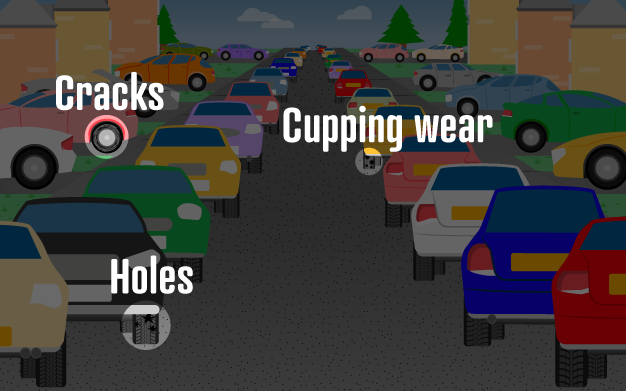Vertu Motors has created some tricky ‘spot-the-danger’ tests to get drivers thinking about their tyres ahead of winter
Winter is just around the corner now – meaning your car’s tyres need to be in tip-top shape to handle those hazardous roads.
The AA recommends changing tyres when temperatures dip around October time, and drivers need to know what healthy tyres look like in order to stay safe.
That’s why vehicle experts Vertu Motors has released a new batch of brain teasers tasking people with identifying hazards.
The puzzles are proving challenging, too – with the record time for completing them correctly currently 45 seconds.
Can you beat it? Have a go below!
Can you find the hazardous tyres stuck in traffic?

Can you find the hazardous tyres in the garage?
Can you find the hazardous tyres on the driveways?
The answers
How did you get on? The answers are all listed below – along with an explanation of the hazards pictured in each scenario.
Peeling
When tyres start to peel, you’ve got a big problem. Rubber coming away from the sidewall can be very dangerous, and in some scenarios it can even cause the tyre to blow if the car is moving fast. Peeling is usually obvious, so be sure to take a look at your tyres and address the situation quickly if you spot any signs of loose rubber.
Blistering
Blistering – the name for the surfacing of lumps or bubbles in the tyre – usually occurs when the tyre has experienced a collision – whether that’s banging against a kerb or falling into a pothole. If ignored, blistering can lead to big issues in the long-term that destroy the tyre completely. If you ever see any blistering, contact your mechanic as soon as possible.
Side wear
Sometimes, tyres can retain their grip in the centre but wear on the outside, leading to a condition known as side wear. Tyres with this ailment will be unreliable in the winter and will need to be checked. To avoid side wear, make sure you’re pumping up your tyres to the correct levels. Often, tyres with smooth edges are in this condition due to being underinflated.
Nail in tyre
If your tyre is damaged by nails, glass or any other sharp object, it will need to be repaired/replaced quickly. Failing to remove these items can result in flat tyres and blowouts.
Cuts
Sometimes, flat tyres are caused by cuts in the sidewall allowing air to escape. The best way to avoid a deflated tyre is by getting your car inspected regularly by experts. You can arrange for your tyres to be checked on the Vertu Motors tyre page.
Centre wear
Centre wear is when the middle tyre treads flatten over time – usually due to tyres being overinflated. In order to prevent centre wear, check your car model’s manufacturing guidelines for air pressure and make sure you pump up tyres to the recommended levels.
Cracks
Cracks in tyres tend to denote a tyre in need of change – having been worn out due to heavy use or exposed to too much sun (which can lead to the quality of the rubber diminishing). As soon as cracks appear, it’s time to switch your tyres.
Holes
Tiny holes will often lead to tyre deflation over time, so they’re worth addressing as soon as they’re spotted. Take your tyre to an expert who will be able to assess the damage and determine the best course of action.
Cupping wear
If your vehicle has a faulty suspension or shock absorbers, it can lead to cupping wear on car tyres. This is when smooth circles arise – which can weaken the tyre and cause it to lose its grip.
A Vertu Motors spokesperson said that ensuring tyres are road-safe is a crucial part of driving – and is even more invaluable at this time of year.
They stated: “The main thing to know is what the signs of tyre damage are and what you need to do to get them road-safe again.
“That’s where Vertu Motors’ winter health check can be a real life-saver – just simply knowing the signs in advance could prevent bigger problems arising when the cold snap really comes down hardest.”
Head on over to the Vertu blog to learn more.





 Bitcoin
Bitcoin  Ethereum
Ethereum  Tether
Tether  XRP
XRP  Solana
Solana  USDC
USDC  TRON
TRON  Cardano
Cardano  Lido Staked Ether
Lido Staked Ether  Avalanche
Avalanche  Toncoin
Toncoin